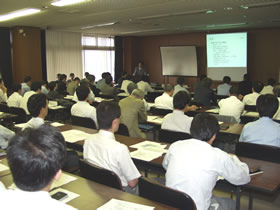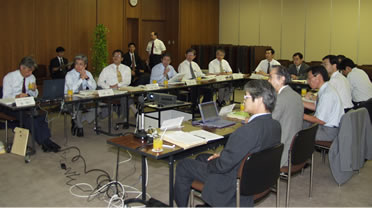|
|
 |
On August 2, 2001, the 22nd Safety Caravan was held at Electric Power Development Company's Head Office, which is located in Chuo-ku, Tokyo.
|
Safety Presentation |
| About 60 people attended the safety presentation, including staff of the Head Office and staff of cooperating companies.
The executive director of Electric Power Development Company opened the lecture with the following greetings: "In the use of nuclear power, it is crucial that all people engaged in their respective jobs be prepared to uphold their duties. I would like to use today's Safety Caravan as reference in establishing our own safety culture, learning from the efforts of other NSnet members."
|

Safety Presentation
|
After the greetings, Secretary-General of the NSnet, Mr. Umezu, introduced NSnet activities. Following that, the lecturer from the Japan Atomic Power Company gave a lecture titled "Fostering nuclear safety and safety culture as seen from the facility maintenance and security office - a report from on site at a power plant," in which he spoke about the creation of a safety culture on site at a nuclear power plant, based on his 30 years of experience in facility maintenance and security.
|
He also spoke in his lecture about the following detailed points:
- "Safety climate" is a pattern of consciousness and action regarding safety and the prevention of accidents that is shared among the members of an organization, becoming something like the atmosphere of that organization. On the other hand, however, in "safety culture," a strong value is placed on safety and accident prevention and positive effort is made to realize these goals. The latter is thus a situation with such concepts and values at the level of corporate ethics, a concept that is much talked about recently, or at the level of simply ethics, in which the feeling with regard to safety is shared by all members of an organization.
- In order to create "safety climate" and "safety culture," it is necessary for all an organization's members to have the consciousness of finding the causes that lead to accidents and breakdowns, such as rule violations, human error and equipment problems, and the like, as well as to have the shared consciousness that such problems exist in most organizations and facilities.
- From the standpoint of fostering a safety climate and a safety culture, it goes without saying how important are basic actions and manners, such as greetings and communication, and the like. And in becoming accustomed to carrying out such basic actions, what is most important are well-regulated organizational training and for the organization's top and management classes to take the lead.
- For preventing accidents and troubles, a situation in which "keeping the facilities in the palm of one's hand" is important. In other words, grasping the reality of facilities with confidence by knowing facility status at the current time, what to do when, and confirming the soundness of such facilities, among others.
|
Discussion session |

Discussion session
|
At the discussion session, NSnet introduced the current status regarding the conducting of a peer review and the exclusive website for the members.
Electric Power Development Company introduced its efforts toward the fostering of a safety culture, including its "YG (wai-gaya: chatting) activities," which comprise small groups conducting free-discussion sessions, as well as its safety education and training for the fostering of future employees engaged in the work of operations and security/maintenance at its Oma Nuclear Power Station.
Among the main opinions to come out of the subsequent discussions included the following:
- What left the deepest impression for me in the peer review were the statements, "In maintaining safety of nuclear power plants, it is necessary to create a safety culture together with the cooperating companies on site," and "Visible public acceptance (PA) activities toward the local community, such as individual visits by plant workers, and the like, are necessary." In the future, I hope that we can make efforts to incorporate the good aspects of other electric power companies in the past and take advantage of its merits for the following operational activities.
- In establishing communication of information related to safety inside the company and with cooperating companies, it is important to create a situation at which opinions can be exchanged in a frank manner, and then exhibiting action based on those opinions.
- The lecturer of the safety presentation made the following comments: "A point of concern in terms of considering safety culture when constructing a plant is the creation of a design based on the total process, from the design stage, construction, operations and maintenance, all the way to shutdown.
|
| |
|
|







